WEIGHT RESTRICTION ON THE OLD SWING BRIDGE
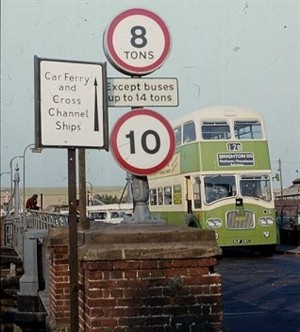
Signs at the town end of the bridge
Richard's photos
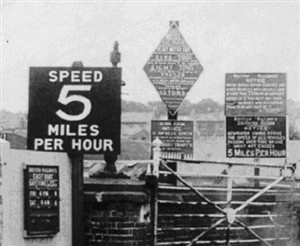
Mass of signs at the eastern end of the bridge
Richard's collection
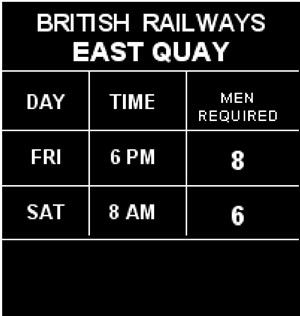
Casual labour required
Richard's collection
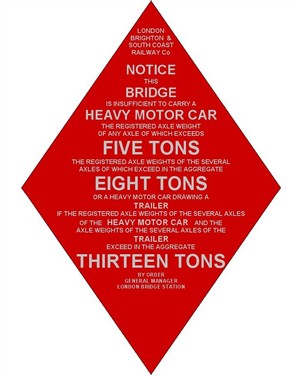
"Diamond Notice Plate" erected by law for 1861 "Locomotive Act"
Richard's photos
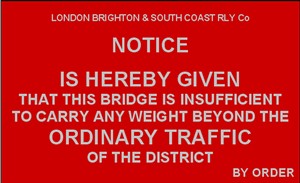
Commonly known as the "Loco Plate" also erected under 1861 Locomotive Act
Richard's photos
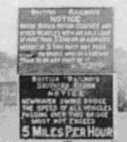
Top Sign states "Two heavy vehicles not permitted to cross at the same time"
Richard's photos
A cacophony of signs
By Richard Beckett
I was employed by British Railways for many years as a structures examiner and the old Swing Bridge and Denton Island Bridge sometimes came within my area of remit. As a result I am posting some pictures and memories here of these old friends of mine.
The first photo was taken at the town end of the swing bridge and shows two large circular signs mounted on a post. The upper one showing 8 Tons while the lower only shows a 10, which doesn't actually indicate what it refers to and like myself at the time many drivers must have been mystified. In the end, the explanation was simple. The 10 was meant to indicate a speed limit in MPH.
The Second photo shows the collection of weight and speed restriction signs, which at one time in the 1960's met the eye of motorists approaching the swing bridge from the Seaford Direction. It was no wonder that at times the restrictions were disobeyed for most motorists would not have had time to read the signs before they were already on the bridge with no chance to stop or turn back.
The sign on the fence immediately to the left of the photo will no doubt bring back memories to our older residents for it was exhibited when casual labour was required for unloading or loading ships coming and going from the port. I seem to recall Jersey potatoes were one such cargo to be unloaded.
The large 5 MPH speed sign next to it needs no explanation.
The large diamond shaped notice and the smaller oblong one directly beneath were both relics from the days when the Swing Bridge (and Denton Island bridge) were owned and maintained by the London Brighton & South Coast Railway. These two notices were erected when Parliament passed the Locomotive Act of 1861 which required Highway & Bridge Authorities to exhibit signs indicating the maximum load which the Highway or Bridge could safely carry. The actual wording on both these notice plates is shown on the coloured pictures. (This was the act that required a man carrying a red flag to walk in front of a moving vehicle.)
At the time the photos were taken the information exhibited on the Diamond and oblong notice plates were not actually legally enforceable because the act had been amended and later repealed some time before, however many authorities left them in-situ as a deterrent to passing motorists who in their ignorance thought they were still legal.
Sometime in the late 1960's or early 1970's, a re-appraisal of the bridge was made with a view to letting heaver vehicles across the bridge. After some deliberation, it was decided that by inserting large timber baulk members under the timber deck it would be possible to allow the maximum vehicle weight to be increased from 5 Tons up to 8 Tons, with buses up to 14 Tons also allowed. Who can ever forget the rattling timber deck as vehicles drove across the bridge?
It may seem strange that since there was a 8 Ton restriction on the bridge a vehicle weighing more than 8 Tons be permitted to cross, (i.e. the signs said a 14 ton bus COULD cross the bridge). The reason was that the axles of a bus are further apart and therefore spread the load over a greater area, which decreased the impact on the girders.
As a little aside to this, during deliberations as to how heavier vehicles could be allowed, a suggestion was made (possibly with good intentions, but more likely as "tongue in cheek") to the effect that when a bus was to cross the bridge, it should stop before crossing and the passengers disembark to make it lighter. The bus would then be driven across while the passengers walked across after which they would then re-embark to continue their journey. Just think of the language on a stormy wet day if that idea had been implemented.
To continue.
Beyond those two notices in the second photo, are a further two which were erected during British Rail ownership and after the limit had been raised to 8 Tons. The upper one of these (which unfortunately is not easily decipherable and I have forgotten the exact wording) refers to the fact that due to the 8 ton weight restriction in force at that time, "..............any vehicle in excess of 8 tons gross weight must not pass across the bridge while a vehicle of similar large weight is on the bridge" This meant for instance that two buses or similar must not be on the bridge at the same time.
The other notice immediately below that again indicates that the maximum speed across the bridge is 5 MPH.
The "diamond" notice plates were gradually removed from all bridges (including the swing bridge) and towards the end of the 1970's I was lucky enough to legally purchase one as a momento for £10. (Unfortunately not the one from the Swing Bridge). When I sold it on after a few years I sold it on for the same price (£10), but to my dismay I have noticed recently that such Collectible items are for sale in Railwayana auctions and can fetch up to £300 for a good specimen. Just my luck.